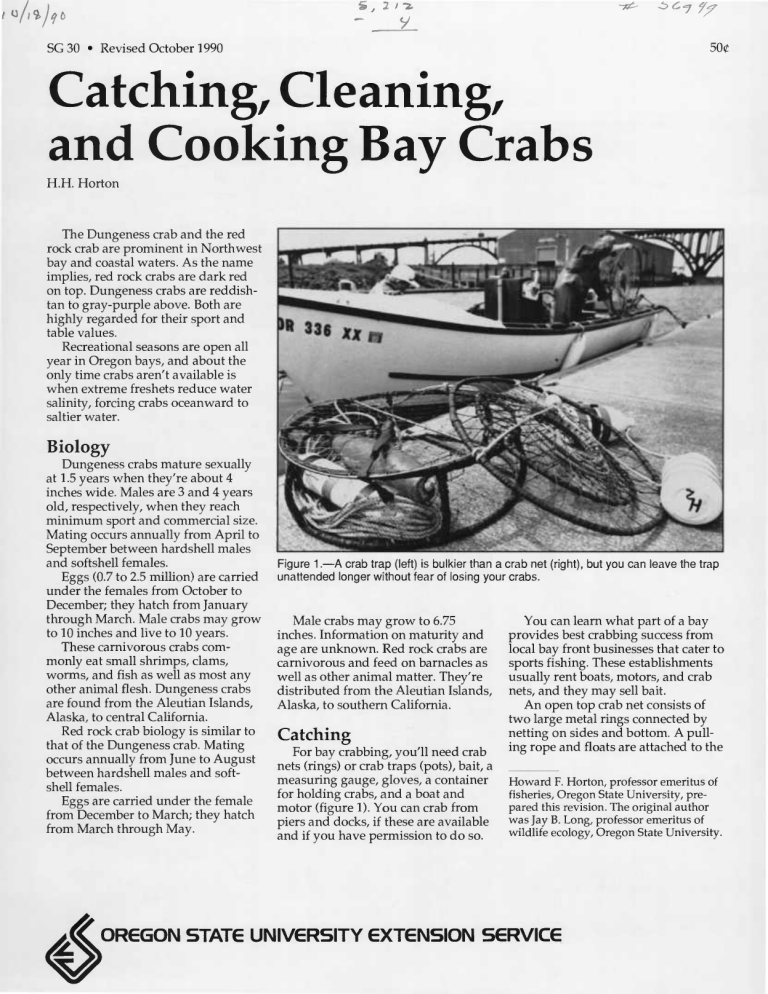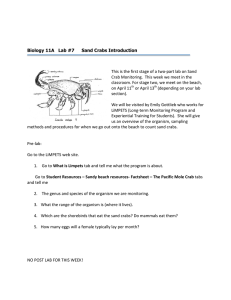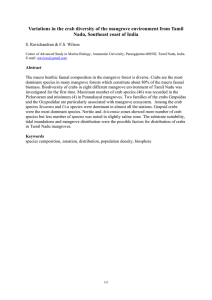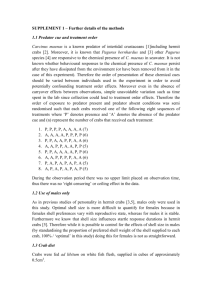Catching, Cleaning, and Cooking Bay Crabs V'V

S y
2 /"i V'V
1 b
SG30 • Revised October 1990
Catching, Cleaning, and Cooking Bay Crabs
H.H. Horton
The Dungeness crab and the red rock crab are prominent in Northwest bay and coastal waters. As the name implies, red rock crabs are dark red on top. Dungeness crabs are reddish- tan to gray-purple above. Both are highly regarded for their sport and table values.
Recreational seasons are open all year in Oregon bays, and about the only time crabs aren't available is when extreme freshets reduce water salinity, forcing crabs oceanward to saltier water.
Biology
Dungeness crabs mature sexually at 1.5 years when they're about 4 inches wide. Males are 3 and 4 years old, respectively, when they reach minimum sport and commercial size.
Mating occurs annually from April to
September between hardshell males and softshell females.
Eggs (0.7 to 2.5 million) are carried under the females from October to
December; they hatch from January through March. Male crabs may grow to 10 inches and live to 10 years.
These carnivorous crabs com- monly eat small shrimps, clams, worms, and fish as well as most any other animal flesh. Dungeness crabs are found from the Aleutian Islands,
Alaska, to central California.
Red rock crab biology is similar to that of the Dungeness crab. Mating occurs annually from June to August between hardshell males and soft- shell females.
Eggs are carried under the female from December to March; they hatch from March through May.
Figure 1.—A crab trap (left) is bulkier than a crab net (right), but you can leave the trap unattended longer without fear of losing your crabs.
Male crabs may grow to 6.75 inches. Information on maturity and age are unknown. Red rock crabs are carnivorous and feed on barnacles as well as other animal matter. They're distributed from the Aleutian Islands,
Alaska, to southern California.
Catching
For bay crabbing, you'll need crab nets (rings) or crab traps (pots), bait, a measuring gauge, gloves, a container for holding crabs, and a boat and motor (figure 1). You can crab from piers and docks, if these are available and if you have permission to do so.
You can learn what part of a bay provides best crabbing success from local bay front businesses that cater to sports fishing. These establishments usually rent boats, motors, and crab nets, and they may sell bait.
An open top crab net consists of two large metal rings connected by netting on sides and bottom. A pull- ing rope and floats are attached to the
Howard F. Horton, professor emeritus of fisheries, Oregon State University, pre- pared this revision. The original author was Jay B. Long, professor emeritus of wildlife ecology, Oregon State University.
50c:
OReGON STATE UNIVERSITY EXTENSION SERVICE
top ring. The pulling rope should be twice as long as the water is deep— for example, use a 40-foot rope when you fish water 20 feet deep.
Mark your floats with your name or with distinct colors for easy iden- tification. A bait holder or bait bag completes the equipment. Crab nets lie flat on the bay bottom when dropped. When retrieved rapidly with the pulling rope, they form a mesh-type net or basket that holds the crabs.
Crab traps may be collapsible or rigid, square or round. Funnels with triggers are located on the sides and allow the crabs to enter, but bar their escape. A retrieving rope, floats, and bait container are also needed.
Compared to nets, crab traps are heavier, bulkier, and more expensive.
However, you can leave traps unat- tended for long periods without fear of losing trapped crabs.
Crabs are attracted by odor, and you can use almost any type of meat for bait (figure 2). Fresh fish carcasses
(except cabezon—crabs' natural enemy) are excellent. If sea lions are likely to rob bait from your net, attach fish carcasses on the underside of the ring or secure them in contain- ers made from hardware cloth.
Red meats such as chicken and turkey backs, condemned beef liver, or other animal parts are effective crab baits, and they don't attract sea lions. Catfood in perforated cans will serve in a pinch.
Relate your crabbing to the tides.
The best crabbing generally occurs at or just before slack tide—either low or high. Best days for crabbing are those when a minimal difference exists between high and low tidal stages. You can obtain tide tables from most sporting goods stores.
Most bay crab fishing parties use several nets or traps when crabbing.
The maximum number per person is set by law, so be sure to consult cur- rent regulations for your area. The gear is usually placed in 10 to 20 feet of water at intervals of 75 to 100 yards.
Lay out your gear in a straight line parallel to—not across—the main tidal or shipping channel so that passing boats can easily maneuver to avoid hitting your ropes or floats.
Pull your nets every 15 to 30 minutes, depending upon how fast the crabs are conning to the bait. You can check traps less frequently.
Figure 2.—Fish carcasses make good bait; you can attach them with wire to your crab net or trap.
Figure 3.—To avoid getting pinched, quickly grasp one or both of the crab's rear legs or the rear central portion of the shell.
Always approach floats against the tide. As your boat nears the net, pick up your floats and gather in the line.
Don't pull the ring until your boat is almost directly overhead. This is
important! If you don't retrieve the net vertically and rapidly, the larger crabs may escape over the top ring.
With traps, pulling can be more leisurely.
The best way to handle crabs is by quickly grasping one of the rear legs or the rear central portion of the shell
(figure 3). Don't run your fingers past the mid point of the under side of the shell. A crab's pinch can be painful and may break the skin. Work fast— crabs have a relatively slow reaction time.
Cleaning
Crabs may be cleaned either before or after they are cooked.
Cleaning before cooking eliminates visceral taste, facilitates salt penetra- tion into the body meat, increases the keeping qualities of the meat, and decreases the size of vessel and the heat required to cook the crabs.
Cleaning after cooking is easier and faster, and protects the body meat from residues in the cooking water.
In either case, the cleaning proce- dure is as follows:
Figure 4.—A measuring gauge helps you determine quickly if the crab is of legal size.
^^^P lr
"*> 1M&&*
,^^0tfp^^iJr4^^ ^^V "^
^^ r^*<w
**5n^oSi*'' ^^P^*B i^i»!r^^v
^^Or^y^
F^ *m
/: ^Sl^^^ f
.— i^
P^A.^J
'^r^z?-'' ""^jp ^Ok*
^SK .^- T i
.*mi*,- -
^Kr i
■■
- '^f%.*t'i> iuL^e **
^/^^
vamsL ^flki
<**
■
^Z iwv^i5
^i ^ SP
■
•^s fj i ^ ^
Figure 5.—Female Dungeness crab (right) has a broad abdomen, or shell flap, on the underside. Male (left) has a narrow abdomen.
Handle undersized crabs and softshell crabs with care; return them immediately to the water to assure survival.
Crabs are measured in a straight line from edge of shell to edge of shell (see figure 4). Retain only hardshell crabs of legal size and sex.
Female crabs are distinguished from male crabs by their relatively broad abdomen (tail flap). This characteristic holds for both Dunge- ness and red rock crabs (figure 5). At present, Oregon law protects female
Dungeness crabs but not female red rock crabs (check current regula- tions).
As crabs grow, they periodically shed and replace their shells. A soft- shell crab is one that has recently shed its shell. You can recognize it by the light and relatively bright shell color, and by the softness and fragil- ity of the shell.
Such crabs are edible, but the flesh is soft and watery, and the shells contain relatively little meat.
1. Remove the carapace (back) of the crab by forcing the edge of the shell against any solid object
(figure 6).
2. Break the crab in two by folding it like a book—first up and then down (figure 7).
3. Shake out the viscera from each half.
4. Pull off the gills and tail flap.
5. Rinse with fresh water. Nothing remains but shell and edible meat.
Cooking
Crabs should be cooked with or without salt as soon as practical after cleaning. If cooking is delayed, be sure to keep the body segments on ice— uncooked crab spoils readily.
To cook with salt, add 3 to 5 ounces of salt per gallon of fresh water
(2 ounces of salt per gallon of bay water).
Bring the water to a boil, drop the body segments in and time for 12 to
15 minutes after the water returns to a boil. Cook whole crabs 20 to 22 minutes in fresh water containing
6 to 8 ounces of salt per gallon.
The procedure is the same for cooking without salt.
After cooking, remove the crabs from the boiling water and immedi- ately immerse them or spray them with
cold water until they're cool. This stops the cooking process, prevents drying and shrinkage of the meat, and tends to prevent the meat from sticking to the shell.
A black discoloration of body meat or shell may occur a few days after cooking. While this discoloration isn't harmful in itself, it does indicate that the crab hasn't been adequately cooked.
Figure 6.—Remove the back by forcing the edge of the shell against any solid object.
Figure 7.—Fold to break in half and shake out viscera from each half.
Regulations
Because regulations for catching crabs may vary from year to year and from State to State, check the current
regulations before you start on a fishing trip. In Oregon, these regula- tions are available at most sporting goods stores where fishing and hunting licenses are sold, and are posted at most crab fishing areas.
For further reading
These publications are available from Publications Orders, Agricul- tural Communications, Administra- tive Services Bldg. 422, Oregon State
University, Corvallis, OR 97331-2119.
Please add 25t shipping and han- dling for orders up to $2.50. For orders between $2.50 and $100, add
15% shipping and handling. For orders of $100 or more, please call
(503) 737-2513 for a price quote.
Hilderbrand, Kenneth S., Jr., Building a Small Crab Cooker for Home Use,
Oregon State University Extension
Service publication SG 70 (Cor- vallis, 1981). 25c
Spears, Carol J., How to Identify a Soft-
shell Crab, Oregon State University
Extension Service publication SG
76 (Corvallis,1983). No charge.
Extension Service, Oregon State University, Corvallis, O.E. Smith, director. This publication was produced and distributed in furtherance of the Acts of Congress of
May 8 and June 30,1914. Extension work is a cooperative program of Oregon State
University, the U.S. Department of Agriculture, and Oregon counties.
The Extension Sea Grant Program is supported in part by the National Oceanic and
Atmospheric Administration, U.S. Department of Commerce.
Oregon State University Extension Service offers educational programs, activities, and materials—without regard to race, color, national origin, sex, age, or disability—as required by Title VI of the Civil Rights Act of 1964, Title IX of the Education Amendments of
1972, and Section 504 of the Rehabilitation Act of 1973. Oregon State University
Extension Service is an Equal Opportunity Employer.





